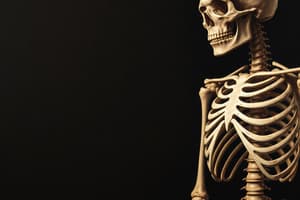Podcast
Questions and Answers
What is the primary focus of osteology?
What is the primary focus of osteology?
- The study of the nervous system
- The study of the cardiovascular system
- The study of muscles and their functions
- The study of the skeletal system and bones (correct)
Which of these terms is most closely related to osteology?
Which of these terms is most closely related to osteology?
- Neurology
- Cardiology
- Myology
- Skeletal Morphology (correct)
What would an osteologist primarily examine?
What would an osteologist primarily examine?
- The flow of blood through arteries
- The composition of bone tissues (correct)
- The structure and function of joints
- The electrical activity of the brain
Which aspect of bones is NOT a direct focus of osteological study?
Which aspect of bones is NOT a direct focus of osteological study?
If a scientist is using techniques such as macroscopic examination and radiography, which field are they most likely working in?
If a scientist is using techniques such as macroscopic examination and radiography, which field are they most likely working in?
Flashcards
Osteology
Osteology
The branch of anatomy that studies bones.
Bone
Bone
A specialized type of connective tissue that forms the skeleton.
Cortical Bone
Cortical Bone
A hard, dense outer layer of bone.
Trabecular Bone
Trabecular Bone
Signup and view all the flashcards
Osteon
Osteon
Signup and view all the flashcards
Study Notes
Introduction to Osteology
- Osteology is the study of the structure and function of bones.
- Bones form the skeletal system, providing support, protection, and leverage for movement.
- Bones also play a vital role in hematopoiesis (blood cell production).
- The skeletal system comprises various bone types.
Types of Bones
- Long bones: Longer than they are wide (e.g., femur, humerus)
- Short bones: Roughly cube-shaped (e.g., carpals, tarsals)
- Flat bones: Thin, flat, and often curved (e.g., ribs, scapulae, skull bones)
- Irregular bones: Complex shapes that don't fit into other categories (e.g., vertebrae, facial bones)
- Sesamoid bones: Small, round bones embedded within tendons (e.g., patella)
Bone Structure
- Compact bone: Dense, hard outer layer of bone
- Spongy bone (cancellous bone): Porous inner layer of bone, composed of trabeculae.
- Bone marrow: Soft tissue residing within bone cavities, vital for hematopoiesis.
- Red bone marrow: produces red and white blood cells and platelets.
- Yellow bone marrow: primarily composed of fat cells.
- Periosteum: Tough fibrous membrane covering the outer surface of bones.
- Endosteum: Thin membrane lining the inner surface of bone cavities.
- Bone matrix: Composed of organic and inorganic components.
- Organic components: primarily collagen fibers, providing flexibility.
- Inorganic components: primarily calcium phosphate, providing hardness.
- Bone cells:
- Osteoblasts: Bone-forming cells
- Osteocytes: Mature bone cells
- Osteoclasts: Bone-resorbing cells (bone breakdown)
Bone Development
- Intramembranous ossification: Bone formation directly within a mesenchymal membrane (flat bones).
- Endochondral ossification: Bone formation by replacing hyaline cartilage (long bones).
- Growth plates (epiphyseal plates): Regions of cartilage that allow bones to grow in length until adulthood.
Bone Markings
- Projections: Processes that extend outward from the bone surface (e.g., tubercles, tuberosities, trochanters, spines).
- Depressions: Cavities or openings in the bone surface (e.g., fossae, foramina, sulci, grooves).
- Condyles: Rounded articular areas where bones meet.
- Epicondyles: Small projections situated above condyles
Skeletal System Functions
- Support: Provides framework for the body.
- Protection: Encloses and shields vital organs (e.g., skull protects brain, ribs protect heart and lungs).
- Movement: Acts as levers for muscles to produce movement.
- Hematopoiesis: Site of blood cell formation.
- Mineral storage: Stores calcium and phosphorus, crucial for numerous bodily functions.
Skeletal Organization
- Axial skeleton: Forms the central axis of the body (skull, vertebral column, ribs, sternum).
- Appendicular skeleton: Bones of the limbs and their girdles (shoulder girdle, pelvic girdle).
Bone Disorders
- Fractures: Breaks in bone tissue.
- Osteoporosis: Loss of bone density, increasing the risk of fractures.
- Arthritis: Inflammation of joints, affecting bone and cartilage.
- Rickets: Disorder affecting bone development due to vitamin D deficiency.
- Paget's disease: Disorder where bone is broken down and reformed more quickly than normal.
Bone Repair
- Hematoma formation: Blood clot forms at the break site.
- Fibrocartilaginous callus formation: Cartilage and fibrous tissue fill the gap.
- Bony callus formation: Cartilage is gradually replaced by bone.
- Bone remodeling: Excess bone is resorbed, and the fracture site is repaired.
Studying That Suits You
Use AI to generate personalized quizzes and flashcards to suit your learning preferences.




